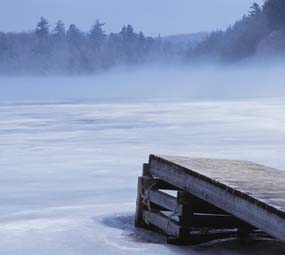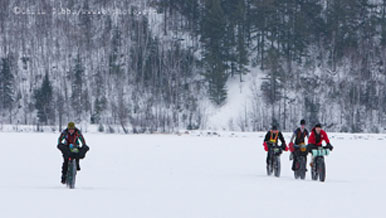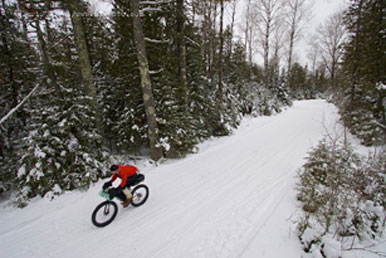Ice, Ice Baby!
Winter activities on Minnesota’s frozen lakes are becoming more and more popular. What with modern insulating clothing, portable fish houses, electronics, great fishing opportunities, and safe, reliable snowmobiles, more people are on the ice than ever before. There is no reason that ice-based activities can’t be enjoyed safely as long as a few simple rules are followed.
When talking to someone about ice, the first thing to keep in mind is that ice is seldom a consistent thickness over the whole body of water. It can be a foot thick in one area and only an inch thick just a few yards away. In fact, you can find a bad spot of ice on just about any frozen lake even during the coldest of winters. It could be where a culvert or a stream exits or enters the lake. Sometimes the gasses bubbling from rotting vegetation or school of rough fish can cause the ice to thin out.

The thicker ice is, the slower freezing happens due to its own insulating properties. At 20 degrees F, it takes less than a day for the ice to freeze from 1” thick to 3” thick. But it takes almost four days to freeze from 9” to 11” at the same temperature. Add the insulating effect of a blanket of snow to the mix and things can really slow down.
With a heavy blanket of snow, all that weight pressing down causes the ice to “dish” or flex downward. Water, seeking it’s own level, seeps up through cracks in the ice. This floods the surface and creates that annoying layer of slush that bogs down snowmobiles and creates all kinds of problems.
We have a set of minimum ice thicknesses for new clear ice to help people determine if it is ok to go out. We say “new clear” ice because new ice is stronger than milky white ice. We recommend a minimum of four inches for walking and small group activities like fishing, cross country skiing, skating and so on. True, slightly thinner ice will support the weight of a single person, but then there is no added “insurance” for when you find that spot where there is a current, rotting vegetation.

Check for known thin ice areas with a local resort or bait shop. Then test the thickness yourself using an ice chisel, ice auger or even a cordless drill with a long wood auger bit.
Refrain from driving on ice whenever possible. If you must drive a vehicle, be prepared to leave it in a hurry – keep windows down, unbuckle your seat belt and have a simple emergency plan of action you have discussed with your passengers.
Stay away from alcoholic beverages. Even “just a couple of beers” are enough to cause a careless error in judgment that could cost you your life. And contrary to common belief, alcohol actually makes you colder rather than warming you up.
Don’t "overdrive" your snowmobile’s headlight. At even 30 miles per hour, it can take a much longer distance to stop on ice than your headlight shines. Many fatal snowmobile through-the-ice accidents occur because the machine was traveling too fast for the operator to stop when the headlamp illuminated the hole in the ice.
Wear a life vest under your winter gear or one of the new flotation snowmobile suits. And it’s a good idea to carry a pair of ice picks that may be home made or purchased from most well stocked sporting goods stores that cater to winter anglers. It’s amazing how difficult it can be to pull yourself back onto the surface of unbroken but wet and slippery ice while wearing a snowmobile suit weighted down with 60 lbs. of water. The ice picks really help pulling yourself back onto solid ice. CAUTION: Do NOT wear a flotation device when traveling across the ice in an enclosed vehicle!
What should you do if a companion falls through thin ice?
- Keep calm and think out a solution.
- Don’t run up to the hole. You’ll probably break through and then there will be two victims.
- Use some item on shore to throw or extend to the victim to pull them out of the water such as jumper cables or skis, or push a boat ahead of you.
- If you can’t rescue the victim immediately, call 911. It’s amazing how many people carry cell phones.
- Get medical assistance for the victim. Some people who are subjected to cold water immersion seem fine after being rescued. However, they can suffer a potentially fatal condition called "after drop" that occurs when cold blood that is pooled in the body’s extremities starts to circulate again as the victim starts to re-warm.
What if YOU fall in?
Try not to panic. Instead, remain calm and turn toward the direction you came from. Place your hands and arms on the unbroken surface of the ice (here’s where the ice picks come in handy.) Work forward on the ice by kicking your feet. If the ice breaks, maintain your position and slide forward again. Once you are lying on the ice, don’t stand. Instead, roll away from the hole. That will spread your weight out until you are back on solid ice. This sounds much easier than it really is to do, so it’s a good idea to carry a pair of ice rescue claws to help get a grip on the slippery ice around a hole. Ice claws can be purchased at most stores that cater to winter anglers or easily homemade with simple tools.
The best advice is don’t put yourself into needless danger by venturing out too soon or too late in the season. No angler, no matter how much of a fishing enthusiast, would want to die for a crappie.







